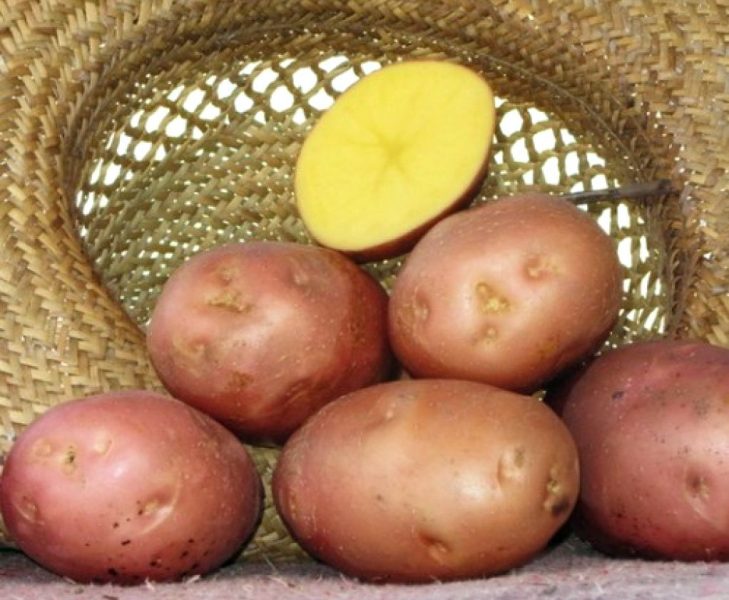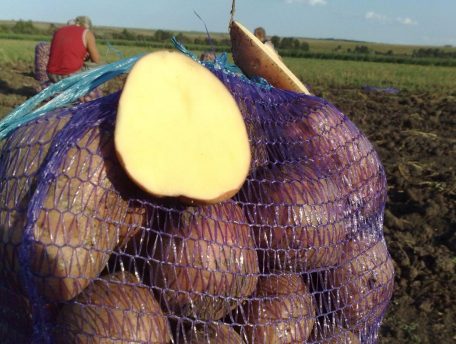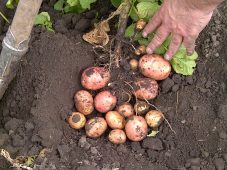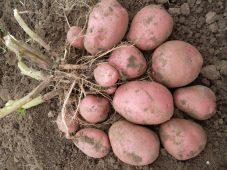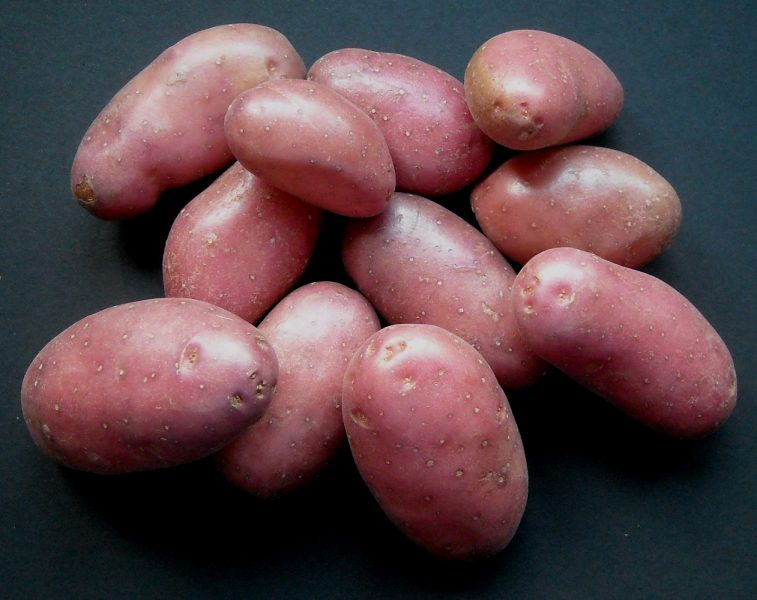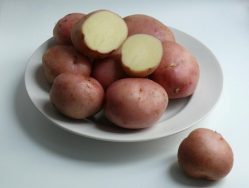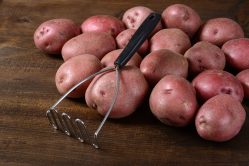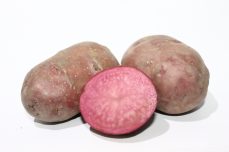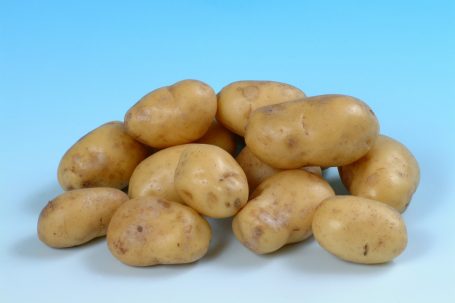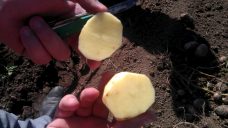Potato is one of the most common and popular vegetable crops, which is cultivated both in small summer cottages and on an industrial scale in the fields. And from the whole variety of different varieties, I want to choose the best variety with high yields, taste, resistance to harmful organisms. Having grown Bellarosa potatoes, the gardener will personally verify that the culture fully meets the declared characteristics.
Material Content:
Variety characteristics and description
The precocious varieties of Bellarosa stand out:
- ultra-early ripening - digging up the ripened tubers is possible already 2 months after planting, and in the southern regions there is the possibility of obtaining 2 crops.
- Stable and fairly high productivity - an average of 200-350 kg / ha.
- Drought tolerance - potatoes are well tolerated by long dry periods.
- A high palatability score - the pulp of potato tubers contains a large amount of starch (up to 15%), on which taste depends.
- High resistance to mechanical injury and disease - the variety is immune to potato cancer, scab, fusarium and alternariosis.
- Excellent durability - losses during storage do not exceed 6%.
Potato bushes consist of semi-erect strong shoots, which are covered with large, juicy leaves of dark green color. The height of the tops can reach 80 cm. Inflorescences differ in average size and red-violet color. From one bush, it is possible to get from 7 to 10 tubers weighing 200-800 g. The fruits are covered with pink skin with barely visible accessory buds.In the section, the flesh is yellowish.
Advantages and Disadvantages of Potato Bellarosa
Potato variety Bellarosa stands out with a host of advantages:
- excellent taste;
- high productivity;
- precocity
- undemanding to the soil composition;
- good tolerance of drought;
- immunity to pathogens;
- resistance to mechanical damage when digging tubers;
- long shelf life.
The only negative is the non-compact arrangement of tubers, which makes it difficult to dig out the crop.
How and when to plant in open ground
2-3 weeks before the expected date of planting, when the soil at a depth of 10 cm warms up to 6 ° C, seed potatoes are distributed in 2 layers in wooden boxes for germination. The containers are transferred to a well-lit room with a temperature of 15 ° C.
Preparation of the site where solanaceous crops were not cultivated last season begins in the autumn, when compost is added for digging at the rate of 7 kg per 1 m2. After the snow melts, the territory is re-excavated with fertilizing with ammonium nitrate, which contributes to the active growth and strengthening of the culture's immunity. Further, the plot is harrowed to close moisture.
Planting of potato tubers to a depth of 8-10 cm is carried out according to a 90x40 cm pattern, where the first digit is the distance between the rows, and the second is between the holes. Seed potatoes are buried, after which the plot is equal.
Agrotechnics of cultivation and care
Proper and regular care is the key to obtaining a high-quality and large crop.
Loosening and weeding
During the season, a minimum of 3 loosening is carried out, which enrich the soil with oxygen. It is recommended that the first procedure be carried out 10-15 days after planting potatoes. Next, it is necessary to take into account the natural precipitation that compacts the soil. Simultaneously with loosening, weed vegetation is removed.
Fertilizing and fertilizers
Early ripening varieties are very sensitive to top dressing.
To get high yields:
- When friendly shoots appear, the potato is fed with organic matter in the form of manure or chicken droppings, diluted in water in a ratio of 1:10.
- During the formation of inflorescences, urea and potash fertilizers are applied under the bushes.
- In the flowering phase, the soil is enriched with phosphorus-containing agrochemicals.
To avoid burns before top dressing, the soil should be moistened or carried out after natural rainfall.
Watering
The Bellarosa variety is drought tolerant and does not need additional watering with natural rainfall. In the case of a snowy winter and a too long dry period, if possible, then the natural moisture reserves should be replenished artificially.
Hilling
When the shoots reach a height of 15 cm, it is necessary to carry out the earthing up, which helps plants to receive water, nutrition and air necessary for the full development of tubers. Thanks to the timely procedure, the bushes do not lie on the ground.
Read also:garden yeast fertilizer
Protection against diseases and pests
Despite the excellent resistance of the variety to diseases and pests, gardeners may encounter the following difficulties:
- Potato Bellarosa can attack the Colorado potato beetle - the main enemy of solanaceous crops. To protect against the pest, it is recommended to carry out pre-sowing treatment of seed tubers with an insecticide disinfectant. And also when examining the bushes in the case of fixing several larvae on the bush, it is recommended to immediately treat with an insecticide.
- A dangerous soil-borne pest that causes great damage to the quality of the crop is wireworm. To protect the potatoes before planting, it is necessary to put the bait on the selected site: to deepen the tubers on sticks by 10 cm, and after a day, remove the traps and destroy them.
- Since the variety of Bellarosa is ultra-ripe, it often does not have time to get infected with such a fungal disease as late blight.However, in regions with a humid climate and during prolonged rains and low temperatures, it is recommended that preventive measures be taken in advance to maintain high yields. After the bushes reach a height of 30 cm, the plants are treated with copper-containing preparations - Bordeaux mixture, vitriol and other fungicides of a similar composition.
Tips for increasing yields
In order to get stable high yields every year or even increase the yield indicator to the declared maximum, all organizational and economic measures should be strictly observed and the integrated plant protection system should be adhered to:
- It is necessary to correctly alternate crops, placing potatoes after cucumbers, beets, cabbage.
- During the autumn preparation of the site, organic fertilizers should be applied to improve soil fertility.
- It is required to loosen the soil in a timely manner and to spud plants, providing good aeration, which contributes to better development of tubers.
- It is necessary to systematically remove weedy vegetation, which takes food from potatoes.
- Comprehensive plant protection should be carried out, which includes preventive and protective measures using pesticides, biological products and manual methods. (Preventing pests can save 15% of the crop).
Potato Bellarosa is a variety with excellent characteristics, including the attractive appearance of tubers, which even an inexperienced summer resident can grow.


